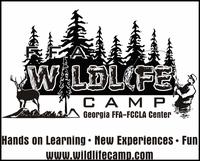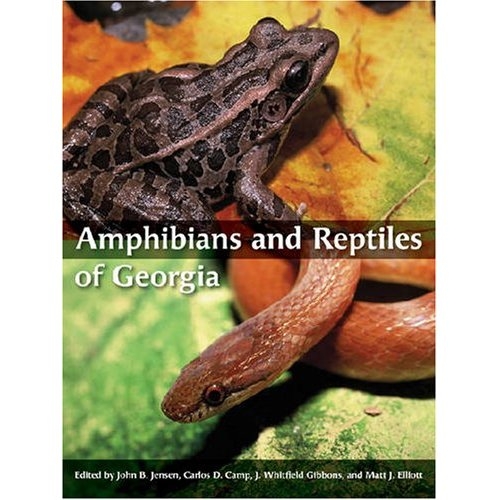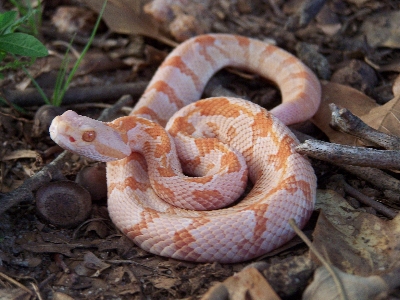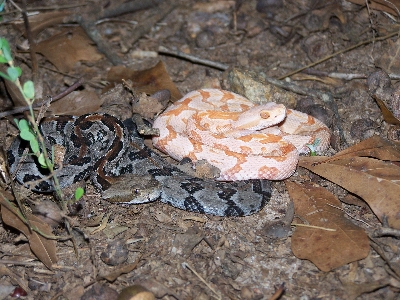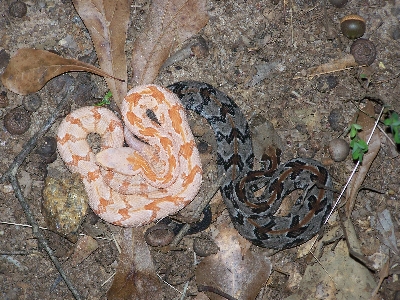Firecracker - The Albino Timber Rattlesnake God sure does make some good looking animals doesn't he! This is one of only two Albino Timber Rattlesnakes to ever be found in Georgia. Due to its unusualy bright coloration, this little fellow would have a tough time effectively hiding from predators. The light color of its eyes reflect light away instead of absorbing it making its vision not as acute as a normal colored rattlesnake. Fortunately, it will be able to live comfortably for the rest of it's life without looking over it's shoulder for predators. That is, if it had shoulders. As of now, we do not know if it is a male or female. When the snake nears sexual maturity, we will have the snake sexed and possibly do a breeding project with it. Our pretty little rattler is named Firecracker. We thought this name to be quite appropriate due to its burst of bright orange color and it's nasty little pop it'll give you if you hold it when it decides to "go off".
Firecracker is featured in "Amphibians and Reptiles of Georgia" pictured below.
|
|
This article appeared in the Douglas Daily News
Robert Preston, Jr. Douglas Daily News
It is with good reason that their cynicism exists. Rattlesnakes often turn out to be gray rat snakes, coral snakes are often harmless scarlet king snakes and six footers are often no longer than two or three feet. So when Jason Clark of Southeastern Reptile Rescue, located in "The person who called told me it was a rattlesnake, and he thought it was an albino, maybe 10 or 12 inches long. I didn't think it was. I figured it was a canebrake rattlesnake with a lot of yellow on it or maybe even a corn snake," said When he finally laid his eyes on the animal in question, he realized that his caller was indeed telling the truth. "It was an albino canebrake, maybe a foot long. It only had a button on its rattle, which means it hasn't even shed yet. It's probably less than two weeks old," said The caller captured the snake on a road in An albino canebrake rattlesnake is indeed a rarity. The canebrake, known in some areas as the timber rattlesnake, is the most widely-distributed of While several albino eastern diamondback rattlesnakes have been found in the wild, only one other albino canebrake has been discovered in In an article from the winter 2000 edition of The University of Georgia Research Magazine, Whit Gibbons, an ecology professor at the "Hopefully, we'll get the snake eating this weekend. In a few months, we'll sex the snake. If it's the opposite sex, we hope to start a breeding project with the other albino," said The little rattler was lucky to be found. Albinos don't usually live very long in the wild. Their coloration, which results from a genetic mutation that alters the pigmentation of the snake's skin, makes albinos of any species easy to locate by both prey and predator alike. That the snake was captured saved its life, and has given researchers around the state something to talk about. The snake's albinism hasn't affected its venom; it is just as dangerous as a normal-colored canebrake. Canebrakes are capable of delivering a deadly dose of venom that contains both hemotoxic and neurotoxic properties. Fortunately, bites are rare and those that do occur are rarely fatal. However, they are very painful and often result in significant tissue damage.
However, snake venom is very useful for a variety of applications. Rattlesnake venom has been successfully used to manufacture a popular heart medication, and copperhead venom is a key ingredient in a medicine used to treat breast cancer.
"We need to conserve these snakes so medical technology can develop to the point that more uses for snake venom can be found," said
At least one other albino canebrake has been found in the wild. According to the reptile portal kingsnake.com, one was discovered in northwestern |
This story appeared in The Macon Telegraph Ecsssscentric specimen By Liz Fabian TELEGRAPH STAFF WRITER
At Southeastern Reptile Rescue, they're accustomed to callers confusing species of snakes or their length - like a 6-foot snake that turns out to be about 3 feet.
But this time, the man on the phone was right. They are now the proud caretakers of an extremely rare baby snake that would likely fall victim to predators without the usual camouflage markings.
"We thought it was a corn snake when the man called us, but when we saw it, we were like, 'Oh, my gosh,' " Sarah Clark said.
The pale yellow albino canebrake or timber rattler is about a foot long with orange markings. But you won't catch it rattling. At less than two weeks old, it only has one tiny button at the end. When it sheds its first skin, it will have another rattle and the two will be able to make the characteristic noise that gives the snake its name.
Suggestions for this snake's name are coming into the couple's Web site, www.SnakesAreUs.com.
And although the snake's sex is not yet know, that's not hindering its attraction.
"We've already gotten people lining up wanting to mate their snakes," Jason Clark said.
Though the snake has a few years to go before hitting puberty, one perfect match could be waiting in
The
J. Whitfield Gibbons, a UGA professor of ecology at the lab, said the
"It's so rare; that's the second one I've ever heard of," Gibbons said Thursday. "It's a beautiful animal. It will be one of a kind."
But in a few years, there could be many if the
The albino strain is a double recessive gene, which means offspring of two albinos will be albinos, Gibbons said.
Gibbons and the Clarks share a love for the slithering creatures. They work to persuade the general public not to harm snakes.
The
Jason Clark developed his affection for snakes when he found his first snake in the side yard when he was 7 years old.
Once his father assured him it was not poisonous, Mike Clark told his son to let it go.
But he didn't.
He kept playing with it until he had been bitten several times.
He excitedly ran into the kitchen and showed his mother the blood dripping from his fingers.
"It was exciting to me," Jason Clark said. "I got my first snake and my first snakebites all in the same day."
These days he keeps an anti-venom "cheat sheet" handy in case he passes out before help arrives. In his animal demonstrations, he has yet to find a doctor or nurse who has treated a venomous snake bite, and he wants to be sure health professionals will know how to save him.
If he gets bitten, he would open the book to the snake that bit him and paramedics would find instructions on how to treat that bite.
Although Sarah first warned Jason she wouldn't marry him unless he built a separate building for the snakes, two years later she's living with dozens of snakes, three alligators - one named Gatorade - and a crocodile named Crockpot.
"I figured if I loved this man, I had to love reptiles," Sarah Clark said.
The whole family is embracing the newest addition, even Jason's mother, who softened over the years after that first horrifying experience.
"I told somebody at work my grandsnake spent the night with me," said Jane Clark. "We now help him with his snake shows."
By day, her son is a
Although both duties worry his mother, his aim is to save lives.
"We try to tell people, 'Leave the snakes alone.' Most snake bites happen when people are trying to kill them," Jason Clark said. "A snake is the lowest creature on the face of the earth, and if we can get people to treat them well, imagine how they'll treat the rest of nature."
The
Professor Gibbons thinks that's a good thing.
"Anything that draws attention to snakes and is of interest to people, it's good for snakes," he said. |
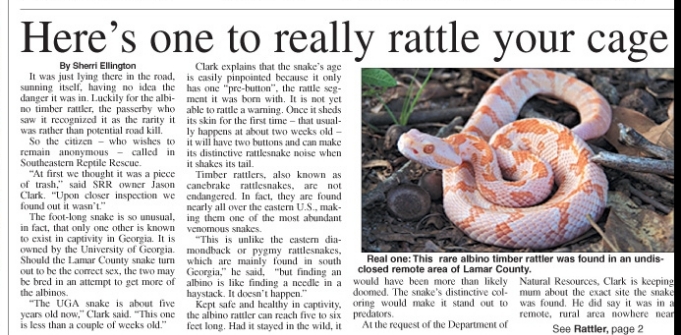 A Most Unusual Canebrake Jason Clark, president and founder of Southeastern Reptile Rescue (www.snakesareus.com), is accustomed to confronting the unexpected. It goes with the job. But even for him, the call he received in mid-September from a Lamar County resident was a surprise. The caller said he'd found an albino snake canebrake rattler he said on a road in the middle Georgia county and wanted Jason's help. Skeptical, Jason went to take a look. "I thought he probably had a corn snake or something pretty common." Sure enough, the little reptile was an albino canebrake rattler (Crotalus horridus). "Very unusual," said Clark. "In fact, it's only the second such snake recorded in Georgia. "I'm glad the man who found him was concerned and gave us the opportunity to save this snake," he continued. "It's very young hadn't even eaten its first meal when we picked it up."Native to Georgia and occurring throughout the state, the canebrake rattler is also known as a timber rattler, although some experts consider the canebrake a subspecies of the timber rattler. According to the Georgia Wildlife Web, a joint information resource of the Georgia Department of Natural Resources and the Georgia Museum of Natural History, the species averages 36 to 60 inches in length and generally is brown, black, yellow, or pinkish, darkening to deep black toward the rear end and tail, with a series of twenty or so brown or black blotches and cross-bands. A reddish brown mid-dorsal stripe is a visual characteristic. Habitat is hardwood forest, rocky outcrops, bottomland hardwood forests, pine flatwoods and cane thickets. The rattlers' breeding season is August through October, with five to twenty young snakes born live (not in eggs). Adults eat rodents, rabbits, squirrels, and occasionally birds, other snakes, lizards and frogs. While the canebrake rattler is not designated with a protected status, some of its preferred habitats are key to the conservation strategies of Georgia's State Wildlife Action Plan (SWAP). A top objective of the plan is to ensure that species of those habitats don't continue to decline. Clark's unusual new charge probably wouldn't have had much chance to survive in the wild. "Rattlers wait for prey, lying partly in the open," said Clark. "They depend on their coloration and patterning to camouflage them; they're not particularly quick movers. "This little guy would have been so obvious lying in its normal habitat that it probably wouldn't have much chance to catch prey." Despite initial worry that it might not eat, a few days later the young snake devoured seven baby mice in a period of about a half hour, proving it was perfectly normal in that regard. |



















